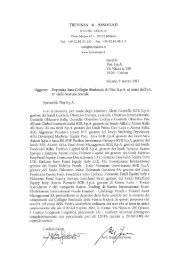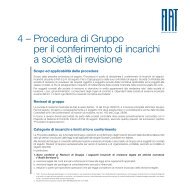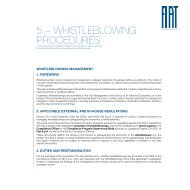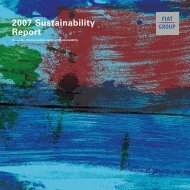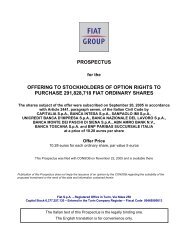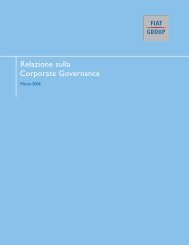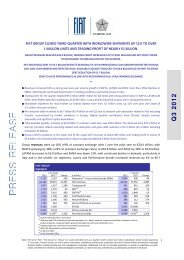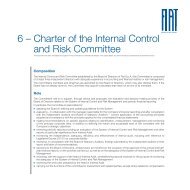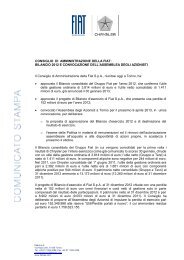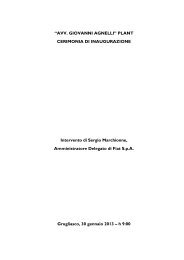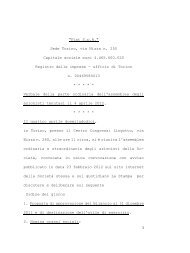annual report - FIAT SpA
annual report - FIAT SpA
annual report - FIAT SpA
Create successful ePaper yourself
Turn your PDF publications into a flip-book with our unique Google optimized e-Paper software.
ecognition in the statement of financial position, inclusive of transaction costs other than in respect of assets held for<br />
trading. These assets are subsequently measured at amortized cost using the effective interest method.<br />
Other non-current assets, trade receivables, current financial receivables and other current receivables,<br />
excluding assets deriving from derivative financial instruments and all financial assets for which published price<br />
quotations in an active market are not available and whose fair value cannot be determined reliably, are measured, to<br />
the extent that they have a fixed term, at amortized cost, using the effective interest method. When the financial assets<br />
do not have a fixed term, they are measured at cost. Receivables with maturities of over one year which bear no<br />
interest or an interest rate significantly lower than market rates are discounted using market rates.<br />
Assessments are made regularly for the purpose of verifying if there is objective evidence that a financial asset,<br />
separately or within a group of assets, may have been impaired. If any such evidence exists, an impairment loss is<br />
included in the income statement for the period.<br />
Non-current financial payables, other non-current liabilities, trade payables, current financial payables and<br />
other payables are measured on initial recognition at fair value (normally represented by their original cost), including<br />
any transaction costs.<br />
Financial liabilities are subsequently measured at amortized cost using the effective interest method, except for<br />
derivative financial instruments and liabilities for financial guarantee contracts. Financial liabilities hedged by<br />
derivative instruments are measured in accordance with hedge accounting principles applicable to fair value hedges.<br />
Gains and losses arising from measurement at fair value, caused by fluctuations in interest rates, are recognized in the<br />
income statement and are offset by the effective portion of the gain or loss arising from remeasurement at fair value of<br />
the hedging instrument.<br />
Liabilities for financial guarantee contracts are measured at the higher of the estimate of the contingent liability<br />
(determined in accordance with IAS 37 - Provisions, Contingent Liabilities and Contingent Assets) and the amount<br />
initially recognized less any amount released to income over time.<br />
Derivative financial instruments<br />
Derivative financial instruments are used for hedging purposes, in order to reduce currency, interest rate and market<br />
price risks.<br />
In accordance with IAS 39, derivative financial instruments qualify for hedge accounting only when at the inception of<br />
the hedge there is formal designation and documentation of the hedging relationship, the hedge is expected to be<br />
highly effective, its effectiveness can be reliably measured and it is highly effective throughout the financial <strong>report</strong>ing<br />
periods for which the hedge is designated.<br />
All derivative financial instruments are measured in accordance with IAS 39 at fair value.<br />
When derivative financial instruments qualify for hedge accounting, the following accounting treatment applies:<br />
� Fair value hedge – Where a derivative financial instrument is designated as a hedge of the exposure to changes<br />
in fair value of a recognized asset or liability that is attributable to a particular risk and could affect the income<br />
statement, the gain or loss from remeasuring the hedging instrument at fair value is recognized in the income<br />
statement. The gain or loss on the hedged item attributable to the hedged risk adjusts the carrying amount of the<br />
hedged item and is recognized in the income statement.<br />
� Cash flow hedge – Where a derivative financial instrument is designated as a hedge of the exposure to variability<br />
in future cash flows of a recognized asset or liability or a highly probable forecast transaction and could affect the<br />
income statement, the effective portion of the gain or loss on the derivative financial instrument is recognized<br />
directly in equity. The cumulative gain or loss is removed from equity and recognized in the income statement in<br />
the same period in which the hedged transaction is recognized. The gain or loss associated with a hedge or part of<br />
a hedge that has become ineffective is recognized in the income statement immediately. When a hedging<br />
instrument or hedge relationship is terminated but the hedged transaction is still expected to occur, the cumulative<br />
gain or loss realized to the point of termination remains in shareholders’ equity and is recognized in the income<br />
statement at the same time as the underlying transaction occurs. If the hedged transaction is no longer probable,<br />
the cumulative unrealized gain or loss recognized in equity is immediately transferred to the income statement. If<br />
hedge accounting cannot be applied, the gains or losses from the fair value measurement of derivative financial<br />
instruments are recognized immediately in the income statement.<br />
Inventory<br />
Inventory consists of contract work in progress related, in particular, to long-term construction contracts between Fiat<br />
S.p.A. and Treno Alta Velocità – T.A.V. S.p.A. (merged into Rete Ferroviaria Italiana S.p.A. from 31 December 2010)<br />
under which Fiat S.p.A. as general contractor coordinates, organizes and manages the work.<br />
Work in progress refers to activities carried out directly and is recognized through measurement of the total contract<br />
Fiat S.p.A. – Statutory Financial Statements at 31 December 2010 266



